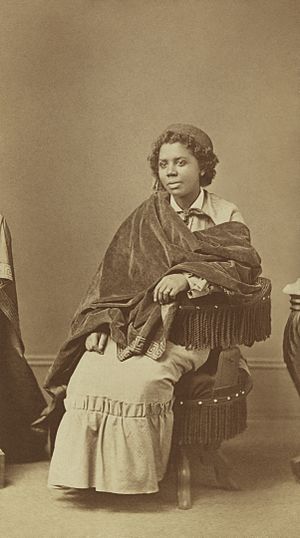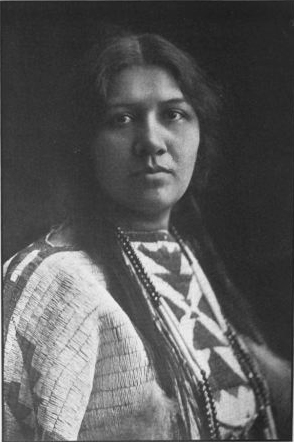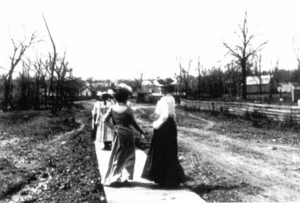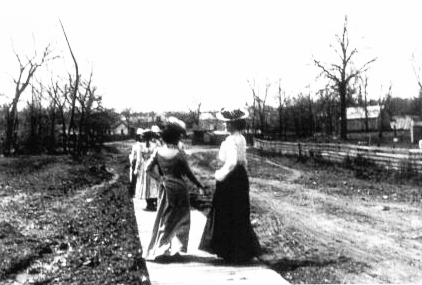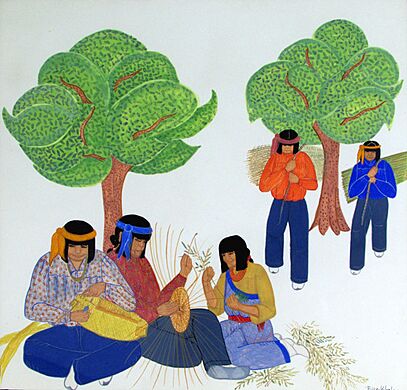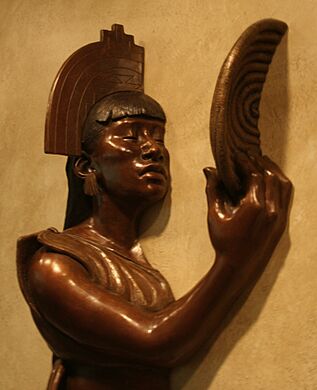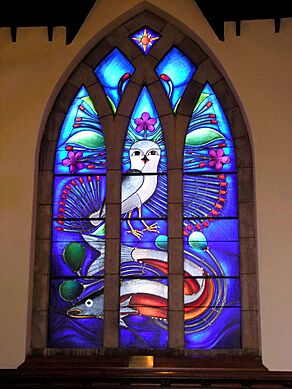Native American women in the arts facts for kids
Native American women have created amazing art for hundreds of years. Their art is often connected to their beliefs, daily life, and beauty. They have passed down traditional crafts through families. They also make modern art like photography, printmaking, and performance art.
Amazing Artists of the 1800s
Edmonia Lewis was a sculptor in the mid-1800s. She was both African American and Ojibwe. Edmonia started college at Oberlin College. This college was special because it was one of the first in the U.S. to accept African American students.
At college, Edmonia changed her Ojibwe name, Wildfire. She felt pressure and faced unfair treatment. In 1863, she moved to Boston. There, she learned from a famous sculptor named Edward Augustus Brackett. She created a sculpture of Colonel Robert Gould Shaw. He led an African American army group called the 54th Regiment.
Many people loved her sculpture, including other artists. The Shaw family even bought it. With the money, Edmonia traveled to Rome, Italy in 1865. In Rome, she learned about neoclassical sculpture. She became the first American woman to train in this style.
In Rome, Edmonia shared a studio with another sculptor, Anne Whitney. Edmonia chose to carve her art directly into marble. This was to show that she did all the work herself. Some artists were accused of having others do their carving.
Edmonia found ideas for her art from her own background. She was also inspired by the fight to end slavery and the Civil War. She admired the poet Henry Wadsworth Longfellow. She even sculpted a bust (a head and shoulders sculpture) of him. Anne Whitney said it was a "creditable performance."
Another famous sculpture by Edmonia is Forever Free. It is made of white marble. This artwork was inspired by the Emancipation Proclamation, which freed slaves. It shows a man with a broken chain, raising his hand. Next to him, a woman is kneeling and praying.
In 1876, Edmonia's art was shown at the Philadelphia Centennial Exposition. Her large sculpture, The Death of Cleopatra, was displayed. In this piece, she showed the Egyptian queen Cleopatra in a very human and weak way. This was new for that time. An artist named William J. Clark said her Cleopatra was very powerful and showed her great talent.
In the late 1800s, Angel De Cora was a Ho-chunk painter and writer. She grew up during a time when the U.S. government tried to make Native Americans live like European Americans. This was part of a policy by President Grant.
Angel's first paintings appeared with her stories in Harper's Magazine. Her stories, The Sick Child and The Grey Wolf's Daughter, helped change ideas about Native Americans. She wrote about feelings and situations everyone could understand.
Angel was good at mixing Native American painting styles with popular European American styles. This mix is sometimes called transculturation. Her art showed the feelings from her stories. Her success in Harper's helped her illustrate children's books about Native Americans.
Her teachers encouraged her to focus on Native American art. They thought art and ethnicity were connected. Angel became a successful artist. But she sometimes felt caught between two different ideas of who she was. People saw her as either a "naive Indian girl" or someone who had successfully adopted American ways.
In 1900, Angel designed the cover for ethnologist Francis LaFlesche's book, The Middle Five. She created her own Native American-inspired writing style for the cover. In 1906, Angel became a professor of Native Indian Art. She taught at the Carlisle Indian Industrial School.
Angel wanted people to appreciate Native American art and history. She believed Native American art should be part of mainstream culture. She felt art was important for Native American culture to survive and thrive. She told her students to mix their Native American art with modern art. This way, they could create items for home design that people would buy. Angel believed art would help Native Americans feel proud of their heritage. She said, "He may shed his outer skin, but his markings lie below that and should show up only the brighter."
The story of Dat So La Lee is almost like a legend. We know that in 1895, Amy and Abe Cohn discovered her. She was working as a washerwoman. They were amazed by her beautiful baskets. In 1899, the Cohns started selling her baskets to tourists near Lake Tahoe.
Dat So La Lee's basket weaving was highly respected. However, the Cohns often presented her in a way that was common for Native Americans at the time. Amy Cohn would give talks where she explained the basket symbols. Dat So La Lee herself would remain silent. The Cohns also made up parts of her life story for their advertisements.
Dat So La Lee created a special basket weaving style called degikup. Amy Cohn liked to say this style was from a time before European settlers arrived. During this period, many people romanticized Native American culture. Amy Cohn even dressed in Native American clothes for her talks. Later, the Cohns announced that Dat So La Lee was going blind. This was a trick to make people want to buy her baskets more.
Artists of the 1900s
In the early 1900s, photography became a new art form. Women quickly used it to share strong messages about who they were. These photographers showed their cultures as strong and important. They used images that were special to Native American cultures. These images told specific stories about their families and tribes. They showed how artists saw their past, present, and future.
Jennie Ross Cobb (Cherokee) helped break stereotypes about Native Americans. She took photos of Cherokee women who looked confident and proud. They were comfortable with both their Cherokee heritage and modern life. Jennie was the great-granddaughter of Cherokee chief John Ross. She started photography as a child in Tahlequah, Oklahoma. Her father gave her a camera.
At that time, formal, posed photos were common. But Jennie preferred to photograph women doing their daily activities. She captured women with great care and understanding. This was because she had a close connection to the people she photographed. As artist Hulleah Tsinhnahjinnie said, Jennie truly saw Native American women "with love and a humanizing eye."
As a child, Mabel McKay (Pomo) had special dreams. These dreams showed her future roles as a healer (a "sucking doctor") and a basket weaver. From these dreams, she learned to weave baskets when she was only six years old. She found ideas for designs and learned about their special uses.
Mabel believed that "baskets are living entities." She thought they were more than just pretty objects. Each basket had a special purpose. She connected baskets to her healing work. She would give a patient a basket of their own. Mabel also taught classes to share her basket weaving skills. She helped introduce traditional basket weaving to people outside the Native American community.
In the 1950s and 1960s, Mabel gave talks at universities and museums in California. She spoke about Native American culture and the art of basket weaving. By 1975, Mabel was known as the last spiritual adviser of the Pomo people. Mabel said about her basket weaving, "It's no such thing art. I only follow my dream. That's how I learn."
By 1920, more people became interested in Native American art. This included art made by Native Americans or art inspired by them. Pop Chalee was from Taos Pueblo. When she was sixteen, she ran away from her mother's home in Utah. She and her family settled in Taos Pueblo. But she often felt like an outsider there. Because of these feelings, her family decided to move back to Utah.
In 1930, Pop Chalee became a student at the Santa Fe Indian School. She studied with Dorothy Dunn. Pop Chalee learned a special design style. This style later became known as the Kiowa Movement. At Dunn's studio, Native American students were encouraged to become artists for the first time. In 1936, Disney bought one of Pop Chalee's paintings. It was used as inspiration for the movie Bambi.
After graduating, Pop Chalee was asked to paint a mural for Maisel's Trading Post. She worked with other artists like Awa Tsireh and Pablita Velarde. Pop Chalee continued to paint murals in places like the Albuquerque Airport and for the Santa Fe Railroad.
Pop Chalee was not only a visual artist. She also performed to promote the movie Annie Get Your Gun. She told stories, gave lectures, and even sang. She often wore traditional Native American dress and beautiful accessories.
Around the same time, another artist named Ellen Neel was making a difference in Canada. She took part in potlatch ceremonies. These ceremonies were banned by both the United States and Canada. They were seen as a "useless custom." Ellen Neel (Kwakwaka'wakw) was a totem woodcarver. She was the first to put her totem designs onto paper and fabric. She also carved small totem poles for tourists.
In 1946, Ellen opened Totem Arts Studios. She worked in an old World War II bunker. She also helped fix and restore older totem poles for the University of British Columbia. But this work was very hard and took a lot of time. She eventually went back to creating her own art. In 1955, Ellen carved five totem poles for a department store called Woodward's. She also carved large poles for Stratford, Ontario, and a museum in Denmark. Even though she was a pioneer, her requests for funding were turned down. She passed away six years later.
As Ellen Neel became famous for her carving, Jaune Quick-To-See Smith (Flathead Salish) was still in high school. She took an art course by mail. Born in 1940, Jaune moved around a lot as a child. Her father was a traveling worker, and she sometimes lived in foster homes. Her father later inspired her art style.
By 1978, Jaune had her first solo art show. This was even before she finished her master's degree in fine arts. Jaune's art often speaks out against how Native cultures' symbols have been misused in art history. Horses, buffalos, and petroglyphs are often seen in her work. In 1994, Jaune said about her art: "My paintings show my feelings about certain things. They are not just general works... Each painting tells a story about something I am thinking about. If I can't connect to it personally, if it doesn't mean something to me... then how can I paint it?"
Jaune Quick-To-See Smith's art also deals with issues like racism, sexism, and the environment. She is a member of Greenpeace. She has organized protests about land rights. She also uses natural art materials.
Artwork
-
Hiawatha, marble, 1868, by Edmonia Lewis.
-
Painting by Angel De Cora.
-
Photograph by Jennie Ross Cobb, circa 1900.
-
Basketmaking, circa 1940, by Pablita Velarde
-
"For Life in all Directions," bronze, by Roxanne Swentzell
-
Window at John Bell Chapel of Appleby College by Kenojuak Ashevak
See also
- List of 20th-century women artists
- List of indigenous artists of the Americas
- List of Native American artists
- Native American Art
- Timeline of Native American art history
- Women artists


